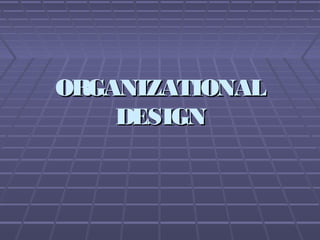
Lecture 3 intro to organizational design
- 2. Organizations: A DefinitionOrganizations: A Definition An organization is defined as two orAn organization is defined as two or more people, working togethermore people, working together cooperatively within identifiablecooperatively within identifiable boundaries, to accomplish a commonboundaries, to accomplish a common goal or objectivegoal or objective
- 3. Four Concepts Implicit inFour Concepts Implicit in Organizational DefinitionOrganizational Definition Organizations are made up of peopleOrganizations are made up of people The necessity of the division of laborThe necessity of the division of labor Organizations have identifiableOrganizations have identifiable boundariesboundaries Organizations are purposeful, goalOrganizations are purposeful, goal seeking work arrangementsseeking work arrangements
- 4. Organizations: A RevisedOrganizations: A Revised DefinitionDefinition Organizations are humanOrganizations are human systems of cooperation andsystems of cooperation and coordination assembledcoordination assembled within identifiablewithin identifiable boundaries, to pursue sharedboundaries, to pursue shared goals or objectivesgoals or objectives
- 6. Importance ofImportance of OrganizationsOrganizations Nearly every aspect of our livesNearly every aspect of our lives is affected by organizations.is affected by organizations. Work, family, health care,Work, family, health care, religion, and entertainment—religion, and entertainment— nearly every facet of life takesnearly every facet of life takes place in, is regulated by, or is aplace in, is regulated by, or is a result of organizations andresult of organizations and organizational actionorganizational action..
- 7. Characteristics ofCharacteristics of Effective StructuresEffective Structures EfficiencyEfficiency: efficient pursuit of goals: efficient pursuit of goals that ensure it does the right thingsthat ensure it does the right things Innovation:Innovation: encourage innovationencourage innovation by providing the pooling ofby providing the pooling of resources and the necessaryresources and the necessary communicationscommunications Flexibility and adaptiveness:Flexibility and adaptiveness: balance the needs for consistencybalance the needs for consistency and predictability with the needs forand predictability with the needs for flexibility and responsivenessflexibility and responsiveness
- 8. Characteristics ofCharacteristics of Effective Structures (cont.)Effective Structures (cont.) Facilitation of Individual Performance andFacilitation of Individual Performance and DevelopmentDevelopment:: offer people the opportunity to performoffer people the opportunity to perform at highest level, encourage growth, and provide aat highest level, encourage growth, and provide a clear career ladderclear career ladder Facilitate Coordination and CommunicationFacilitate Coordination and Communication: must: must facilitate coordination and communication at thefacilitate coordination and communication at the times it is needed mosttimes it is needed most Facilitate Strategy Formulation and ImplementationFacilitate Strategy Formulation and Implementation:: as organizations adopt new strategies, they may needas organizations adopt new strategies, they may need to modify their designsto modify their designs
- 9. What is Organizational Structure?What is Organizational Structure? TheThe structurestructure of an organization can beof an organization can be defined simply as the sum total of thedefined simply as the sum total of the ways in which its labor is divided intoways in which its labor is divided into distinct tasks and then its coordinationdistinct tasks and then its coordination is achieved among these tasks.is achieved among these tasks.
- 10. What is an Organizational Chart?What is an Organizational Chart? Boxes show how work and responsibilitiesBoxes show how work and responsibilities are clustered into units such as divisions,are clustered into units such as divisions, departments, sections, and teams.departments, sections, and teams. Lines show the management structure:Lines show the management structure: Who reports to whom, how the boxesWho reports to whom, how the boxes relate to each other in the hierarchy.relate to each other in the hierarchy.
- 11. Why Organizational StructureWhy Organizational Structure Matters?Matters? Structure affects:Structure affects: What employees pay attention toWhat employees pay attention to Ease of coordinating activitiesEase of coordinating activities Speed of producing goods/servicesSpeed of producing goods/services Cost of running the businessCost of running the business Nature and extent of supervision requiredNature and extent of supervision required Whom employees interact and buildWhom employees interact and build relationships withrelationships with
- 12. Organizational StructureOrganizational Structure Organizational designOrganizational design Selecting the structure and controlSelecting the structure and control systems that are most strategicallysystems that are most strategically effective for pursuing sustainableeffective for pursuing sustainable competitive advantage.competitive advantage. The role of structure and controlThe role of structure and control To coordinate strategy implementation.To coordinate strategy implementation. To motivate and provide incentives for superiorTo motivate and provide incentives for superior performance.performance.
- 13. The Role of OrganizationalThe Role of Organizational StructureStructure Building blocks of organizational structureBuilding blocks of organizational structure Differentiation in the allocation of people andDifferentiation in the allocation of people and resources to create value.resources to create value. Vertical differentiation in theVertical differentiation in the distribution of decision-makingdistribution of decision-making authority.authority. Horizontal differentiation inHorizontal differentiation in dividing up people and tasksdividing up people and tasks into functions and divisions.into functions and divisions. IntegrationIntegration The means used in coordinating people andThe means used in coordinating people and functions to accomplish organizational tasks.functions to accomplish organizational tasks.
- 14. How OrganizationalHow Organizational Design IncreasesDesign Increases ProfitabilityProfitability Enhances a company’s